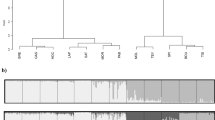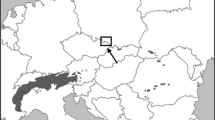Abstract
A pilot survey of three closely spaced Pinus sylvestris L. populations (dry land, bog land, and technogenic (growing on the sandy base of a cluster drilling pad)) has been performed in the oil-producing region of Western Siberia using six polymorphic microsatellite nuclear DNA markers. The data indicate that the populations are quite similar in main genetic variability parameters estimated on the basis of six polymorphic loci. Subtle, although statistically significant, differences were identified between the dry land and bog land populations, including differences in FIS. The technogenic population occupies an intermediate position between the studied natural populations and does not differ statistically significantly from them. Apparently, this is because young technogenic pine stands are a mixture of dry land and bog land genotypes, while the appearance of unique (private) alleles in the technogenic population and the adjacent bog land population could be induced by chemical pollution.

Similar content being viewed by others
REFERENCES
Abolin, R.I., Swamp forms of Pinus silvestris L., Tr. Bot. Muz. Akad. Nauk, 1915, vol. 14, p. 62-84.
Chizhov, B.E., Les i neft' Khanty-Mansiiskogo avtonomnogo okruga (Forest and Oil of Khanty-Mansiysky Autonomous District), Tyumen: Yu. Mandriki, 1998.
Chizhov, B.E. and Cherkashina, M.V., Reclamation of lands disturbed during exploration, development and operation of oil and gas fields, Problemy toplivno-energeticheskogo kompleksa Zapadnoi Sibiri (Problems of the Fuel and Energy Complex of Western Siberia), 2009, pp. 382–391.
Devey, M.E., Bell, J.C., Smith, D.N., et al., A genetic linkage map for Pinus radiata based on RFLP, RAPD and microsatellite markers, Theor. Appl. Genet., 1996, vol. 92, pp. 673–679.
Elsik, C.G., Minihan, V.T., Hall, S.E., et al., Low-copy microsatellite markers for Pinus taeda L., Genome, 2000, vol. 43, pp. 550–555.
Galinskaya, T.V., Shchepetov, D.M., and Lysenkov, S.N., Prejudices against microsatellite studies and how to resist them, Russ. J. Genet., 2019, vol. 55, no. 6, pp. 657–671.
Gladkov, Yu.F. and Sheikina, O.V., Genetic polymorphism of the Pinus sylvestris trees from bog land and dry land cenopopulations on nuclear SSR loci, Vestn. Povolzh. Gos. Technol. Univ., 2019, vol. 4, no. 44, pp. 70–79.
Il’inov, A.A. and Raevskii, B.V., The current state of Pinus sylvestris L. gene pool in Karelia, Sib. Lesn. Zh., 2016, no. 5, pp. 45–54.
Kal’ko, G.V., The testing of nuclear microsatellite markers of Scots pine, Tr. S.-Peterb. Nauchno-Issled. Inst. Lesn. Khoz., 2017, no. 1, pp. 23–34.
Kamalov, R.M., Petyurenko, M.Yu., and Degtyareva, A.P., Testing of microsatellite markers to assess the level of genetic diversity of Pinus sylvestris L., Tr. S.-Peterb. Nauchno-Issled. Inst. Lesn. Khoz., 2022, no. 4, pp. 18–30.
Kapel’kina, L.P., Malyshkina, L.A., and Chugunova, M.V., Remediation of oil-contaminated bog soils, in Biologicheskaya rekul’tivatsiya narushennykh zemel’ (Biological Restoration of Disturbed Lands), Ekaterinburg: Ural. Otd. Ross. Akad. Nauk, 2003, pp. 150–160.
Larionova, A.Ya. and Ekart, A.K., Genetic diversity and differentiation of swamp populations pine, Khvoinye Boreal’noi Zony, vol. 27, nos. 1–2, 2010, pp. 120–126.
Makhatkov, I.D., Tarakanov, V.V., and Tyupina, V.M., Phenetic structure of pine populations in dry valleys and swamps of Western Siberia, Khvoinye Boreal’noi Zony, 2007, vol. 24, nos. 2–3, pp. 248–250.
Mudrik, E.A., Belokon’, M.M., Belokon’, Yu.S., et al., Estimation of the mating system in Pinus cembra L. populations by isozyme and microsatellite markers, Byull. Gos. Nikitsk. Bot. Sada, 2010, no. 101, pp. 89-9-2.
Nei, M., Genetic distance between populations, Am. Nat., 1972, vol. 106, pp. 283–292.
Nei, M., F-statistics and the analysis of gene diversity in subdivided populations, Ann. Hum. Genet., 1977, vol. 41, pp. 225–233.
Nei, M. and Chesser, R.K., Estimation of fixation indices and gene diversities, Ann. Hum. Genet., 1983, vol. 47, pp. 253–259.
Omasheva, M.E., Aubakirova, K.P., and Ryabushkina, N.A., Molecular markers. Causes and consequences of genotyping errors, Biotekhnol., Teor. Prakt., 2013, no. 4, pp. 20–28.
Oreshkova, N.V., Sedel’nikova, T.S., Pimenov, A.V., and Efremov, S.P., Analysis of genetic structure and differentiation of the bog and dry land populations of Pinus sibirica Du Tour based on nuclear microsatellite loci, Russ. J. Genet., 2014, vol. 50, pp. 934–941.
Pan, F., Shihui, N., Huwei, Y., et al., Development and characterization of 25 EST-SSR markers in Pinus sylvestris var. Mongolica (Pinaceae), Appl. Plant Sci., 2014, vol. 2, no. 1, pp. 1–4.
Peakall, R. and Smouse, P.E., GENALEX 6: genetic analysis in Excel. Population genetic software for teaching and research, Mol. Ecol. Notes, 2006, no. 6, pp. 288–295.
Petrova, I.V. and Sannikov, S.N., Izolyatsiya i differentsiatsiya populyatsii sosny obyknovennoi (Isolation and Differentiation of Scots Pine Populations), Ekaterinburg: Ural. Otd. Ross. Akad. Nauk, 1996.
Petrova, I.V., Sannikov, S.N., Cherepanova, O.E., et al., Genetic differentiation of dry land and bog populations of scots pine on the Russian plain, Izv. Vyssh. Uchebn. Zaved., Lesn. Zh., 2013, vol. 6, no. 336, pp. 29–37.
Sebastiani, F., Pinzauti, F., Kujala, S.T., et al., Novel polymorphic nuclear microsatellite markers for Pinus sylvestris L., Conserv. Genet. Resour., 2011, vol. 4, pp. 231–234.
Sedykh, V.N., Technogenic forests on the disturbed lands of Western Siberia, Sib. Lesn. Zh., 2016, no. 2, pp. 43–50.
Sheikina, O.V., Gladkov, Yu.F., and Demakov, Yu.P., Genetic structure of dry land and swamp cenopopulations of Scotch pine in the Republic of Mari El, Materialy XII Vserossiiskogo populyatsionnogo seminara pamyati N.V. Glotova (1939–2016) “Problemy populyatsionnoi biologii” (Proc. XII All-Russian Population Seminar in Memory of N.V. Glotov (1939–2016) “Problems of Population Biology”), Yoshkar-Ola: Spring, 2017, pp. 262–265.
Sheller, M., Toth, E.G., Ciocirlan, E., Mikhaylov, P., Kulakov, S., Kulakova, N., Melnichenko, N., Ibe, A., Sukhikh, T., and Curtu, A.L., Genetic diversity and population structure of scots pine (Pinus sylvestris L.) in Middle Siberia, Forests, 2023, vol. 14, p. 119.
Sivolapov, V.A., Loginova, L.A., Vorob’eva, E.A., Veprintsev, V.N., and Shchetinkin, S.V., Common oak and scots pine subpopulations genetic changes under prolonged exposure to low doses of radiation, Lesn. Vestn., 2022, vol. 26, no. 3, pp. 14–20.
Solntseva, N.P., Dobycha nefti i geokhimiya prirodnykh landshaftov (Oil Recovery and Natural Landscape Geochemistry), Moscow: Mosk. Gos. Univ., 1998.
Soromotin, A.V., Vozdeistvie dobychi nefti na taezhnye ekosistemy Zapadnoi Sibiri (Impact of Oil Production on the Taiga Ecosystems of Western Siberia), Tyumen: Tyumen. Gos. Univ., 2010.
Sukachev, V.N., About the swamp pine, Lesn. Zh., 1905, vol. 35, no. 3., pp. 354–372.
Van Oosterhout, C., Hutchinson, W., Wills, D., and Shipley, P., Micro-checker: software for identifying and correcting genotyping errors in microsatellite data, Mol. Ecol. Resour., 2004, no. 4, pp. 535–538.
Vidyakin, A.I., Phene of forest woody plants: isolation, scaling and use in population studies (on the example of Pinus sylvestris L.), Ekologiya, 2001, no. 3, pp. 197–202.
Zhivotovskii, L.A., Integratsiya poligennykh sistem v populyatsiyakh (Integration of Polygene Systems in Populations), Moscow: Nauka, 1984.
Zhivotovskii, L.A., Microsatellite variation in human populations and the methods of their analysis, Vestn. Vavilovskogo O-va. Genet. Sel., 2006, vol. 10, no. 1, pp. 74–96.
ACKNOWLEDGMENTS
We are grateful to reviewers for constructive remarks resulting in a partial revision of the manuscript.
Funding
This study was performed as part of the Base Project (State Task) of the Federal Research Center Krasnoyarsk Science Center, Siberian Branch, Russian Academy of Sciences, project no. 121031500336-9 (Functional–Dynamic Biodiversity Indication in Siberian Forests).
Author information
Authors and Affiliations
Corresponding authors
Additional information
Translated by L. Emeliyanov
Rights and permissions
About this article
Cite this article
Tarakanov, V.V., Khomutova, K.G. Genetic Structure of Technogenic Forests in the Oil-Producing Region of Western Siberia: Problem Statement. Contemp. Probl. Ecol. 16, 672–678 (2023). https://doi.org/10.1134/S1995425523050128
Received:
Revised:
Accepted:
Published:
Issue Date:
DOI: https://doi.org/10.1134/S1995425523050128




